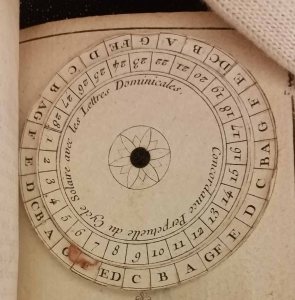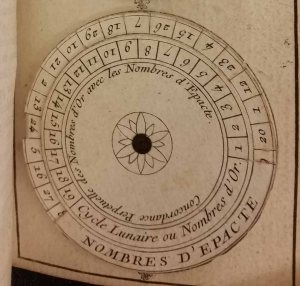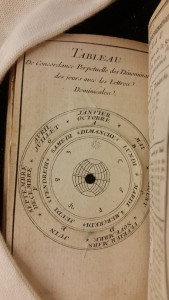Volvelles
Amy Bishop
I’ll confess: I love a book with moveable parts. I mean, who doesn’t? Who can resist the marvels of a pop-up book, or forgo exploring the many forms that artists’ books can take? In our library’s collections, with our focus on science and agriculture, I may not encounter too many pop-up books, but to my immense joy, early scientific books used a variety of strategies to communicate complex information, including different types of moveable parts. [1]
The latest purchase in this category is a book with volvelles. A volvelle is “‘A device consisting of one of more movable parchment or paper discs rotating on string pivots and surrounded by either graduated or figured circles. With its help problems concerning the calendar, tide tables, astronomy and astrology could be solved’ (H.M. Nixon)” (Carter 218). It is a type of movable chart, round in shape with two or more layers. If you think of a star chart, the round kind with a little window that lets you see the stars visible in the sky during a certain time of year, you get the idea of a very simple, modern version of the volvelle.
In the days before computers and modern calculators, volvelles provided scientific readers with the means of making specific calculations. The earliest known surviving example of a volvelle is found in a 13th century manuscript by Ramon Llull, Ars Magna, which is held by the British Library. The first printed volvelle appears in 1474 in Johannes Regiomontanus’ lunar calendar (Karr 101).
Earlier this year I purchased Calendrier perpétuel rendu sensible et mis à la portée de tout le monde, published in Paris in 1774, which assists readers with calendar-related calculations, specifically those related to the liturgical calendar of the Catholic church, including saints’ days, moveable feasts, and dominical letters. Read on for a detailed look at the volvelles in this book, with the caveat that I am not a volvelle expert! Any comments and corrections from those with more knowledge are welcome.
This particular book includes three volvelles. The first page includes 2 volvelles on one page. The top one reads, Concordance perpetuelle du cycle solaire avec les lettres dominicales.

The outer edge of the large disc is inscribed with boxes of dominical letters. Dominical letters are used to determine the day of the week for any given date. The letters A through G are assigned to the days in the week, beginning with A for January 1. The dominical letter for any given year indicates the letter that is assigned to Sunday for that year. For leap years, two letters are assigned because throughout January and February, Sunday will fall on a particular letter. After February 29, Sunday will fall on the next letter in the sequence.
The inner disc on the top volvelle is outlined in numbered boxes from 1 to 28. This corresponds to the solar cycle (cycle solaire), the 28-year cycle of the Julian calendar. There are 7 possible days to start a leap year, and leap years occur every 4 years, thus creating a 28-year sequence of days on which the new year will begin. So, this volvelle appears to match up the year in the solar cycle with the dominical letter for that year.
The bottom volvelle reads, Concordance perpetuelle des nombres d’Or avec les nombres d’Epacte.

The larger disc appears to give the epact numbers (nombres d’epacte), or the number of days’ difference between the solar and lunar calendars. The inner disc lists numbers 1-19, to indicate a year’s golden number (nombres d’Or), or its position in a 19-year Metonic cycle. The Metonic cycle refers to the period of 19 years after which the new and full moons will return to the same days of the year. These are used to determine the dates of moveable feasts, notably Easter.
The recto, or reverse side of the page, has a third volvelle.

The base disc has dominical letters A-G matched up against the names of their corresponding months. The second disc has the days of the week along with their matching astrological sign. This, I imagine, helps the reader to calculate the day of the week that begins each month in a given year. I assume this is for common years only, rather than leap years.
Aren’t your fingers just itching to move those discs?
About this entry
Original post: Rare Book Highlights: Volvelles
Publication Date: July 5, 2018
References
- Carter, John. ABC for book collectors. New Castle, DE, Oak Knoll Press, 1997.
- G.S.H. Calendrier perpétuel rendu sensible et mis à la portée de tout le monde… Paris, P. Fr. Gueffier, 1774.
- Karr, Suzanne. “Constructions Both Sacred and Profane: Serpents, Angels, and Pointing Fingers in Renaissance Books with Moving Parts.” Yale University Library Gazette, vol. 78, no. 3/4, 2004: 101–127,
- See, for example, my earlier post on an early 20th century French technical encyclopedia. ↵

